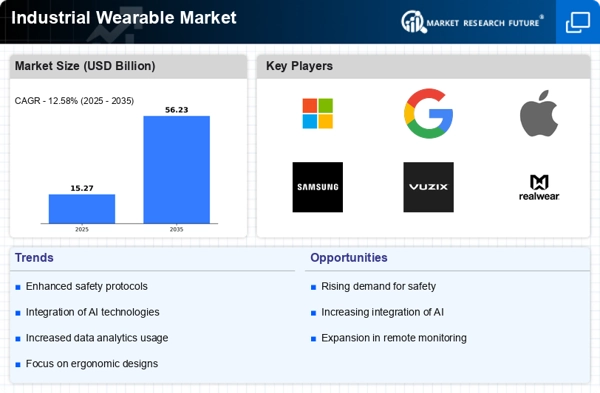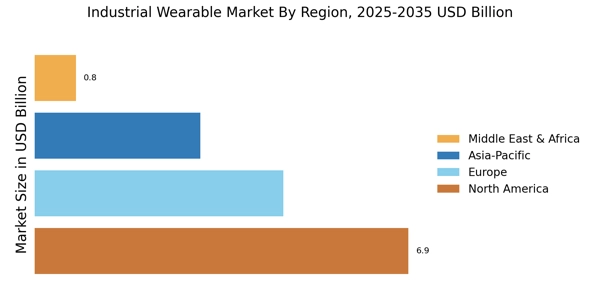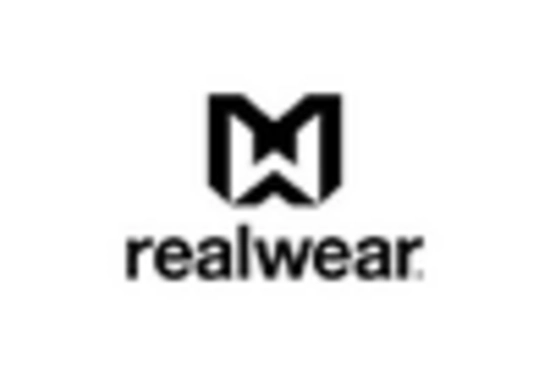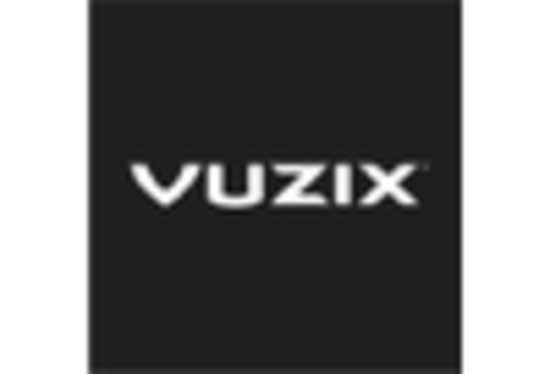Integration of Advanced Sensors
The integration of advanced sensors in the Industrial Wearable Market is transforming how data is collected and analyzed in real-time. These sensors can monitor various parameters such as heart rate, body temperature, and environmental conditions, providing critical insights into worker health and safety. As industries increasingly prioritize data-driven decision-making, the demand for wearables equipped with sophisticated sensors is likely to rise. Reports indicate that the market for wearable sensors is projected to grow significantly, potentially reaching a valuation of several billion dollars by 2026. This trend suggests that companies are investing in technologies that enhance operational efficiency and worker well-being, thereby driving the Industrial Wearable Market forward.
Advancements in Battery Technology
Advancements in battery technology are playing a crucial role in the evolution of the Industrial Wearable Market. Longer-lasting and faster-charging batteries enhance the usability of wearable devices, making them more appealing to industries that require continuous monitoring. Innovations such as energy harvesting and improved lithium-ion batteries are enabling wearables to operate for extended periods without frequent recharging. This development is particularly important in sectors where downtime can lead to significant losses. As battery technology continues to improve, it is anticipated that the Industrial Wearable Market will experience increased adoption rates, with projections indicating a potential market size growth of over 15% annually. This trend highlights the importance of reliable power sources in the functionality and acceptance of industrial wearables.
Enhanced Worker Safety Regulations
The implementation of enhanced worker safety regulations is a pivotal driver in the Industrial Wearable Market. Governments and regulatory bodies are increasingly mandating the use of wearables that can monitor worker safety in hazardous environments. For instance, regulations may require the use of devices that track exposure to harmful substances or alert workers to dangerous conditions. This regulatory push not only ensures compliance but also fosters a culture of safety within organizations. As a result, the market for industrial wearables is expected to expand, with estimates suggesting a compound annual growth rate of over 20% in the coming years. This trend underscores the importance of safety in driving innovation and adoption within the Industrial Wearable Market.
Growing Demand for Remote Monitoring
The growing demand for remote monitoring solutions is significantly influencing the Industrial Wearable Market. As industries seek to optimize operations and reduce costs, the ability to monitor workers remotely has become increasingly valuable. Wearable devices equipped with connectivity features allow for real-time data transmission, enabling supervisors to track worker performance and health from a distance. This capability is particularly beneficial in sectors such as manufacturing and construction, where on-site conditions can be unpredictable. Market analyses suggest that the remote monitoring segment of the Industrial Wearable Market could witness substantial growth, potentially doubling in size over the next five years. This trend indicates a shift towards more flexible and efficient workforce management strategies.
Rise of Data Analytics in Wearable Technology
The rise of data analytics in wearable technology is emerging as a key driver in the Industrial Wearable Market. As organizations collect vast amounts of data from wearable devices, the ability to analyze this information effectively becomes paramount. Advanced analytics can provide insights into worker performance, health trends, and operational efficiencies, allowing companies to make informed decisions. The integration of artificial intelligence and machine learning into wearable technology is further enhancing these capabilities, enabling predictive analytics that can foresee potential issues before they arise. Market forecasts suggest that the analytics segment within the Industrial Wearable Market could grow significantly, with an expected increase in investment in data-driven solutions. This trend indicates a shift towards a more analytical approach in managing workforce health and productivity.

















Leave a Comment